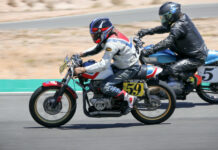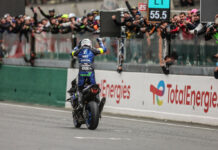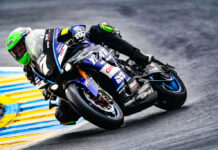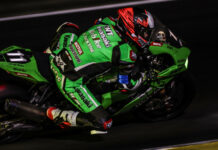Interview with KTM Technical Director Harald Bartol “We will improve – and stay on top!” KTM has made it to the top in the 250 cc category in just three years of development. KTM Racing News talks to Technical Director Harald Bartol about the extraordinary talents of world championship leader Mika Kallio, his high hopes for the title hunt and the rocky path in this year’s 125 cc campaign. Q: Mika Kallio is leading the 250 cc world championship. How much credit should go to the rider and how much to the motorcycle? He deserves a lot of credit for this achievement, without a shadow of a doubt. But I never tried to come up with percentages and I never will. The important thing for me is that we were strong right from the start of the season and there were no significant weaknesses. And I believe that we will be able to improve step by step, wherever necessary, from now to the end of the season. But we also shouldn’t forget that luck has been on Mika’s side for a change this year. We don’t hide the fact that some of our opponents have made mistakes and we’ve benefited from that. We also know that we have to improve, because the others won’t always be riding to our advantage. The Catalunya Grand Prix showed how quickly things can turn around. Q: Great achievers, so they say, create their own luck. Is Mika the best and strongest of your riders? He certainly is. Mika knows how to avoid getting too entangled in technical issues. Instead, he’s able to fully concentrate on himself and because of this he can compensate for certain technical shortfalls. He just doesn’t waste his mental energy. He’s able to assess the situation and say to himself: Things are the way they are, and if I don’t have anything else at my disposal, I make the best out of it. Others tend to keep looking and racking their brains about further improvements. Sometimes they end up with exactly the opposite. Q: Is there anything in Mika’s cool Finnish character that gives him an advantage over his Southern European competitors? Maybe. But Mika is not only cool; he’s also got a great sense of humour. And the most remarkable thing about him is his trust. He seems to have full confidence in us and in what we prepare for him. Our Technical Manager Mario Galeotti once said: You can find two tenths of a second in the set-up of the motorcycle, but not always a full two seconds in the head of a rider. And Mika is able to come up with these two seconds in the most unlikely circumstances – in Valencia, at the end of last year’s season, for example. Mika was on pole position, and right before the start he said: The quick-shifter doesn’t work. I answered: There’s nothing we can do to fix it now. Try to shift 200 revs earlier and the system will work. He said: Okay, will do. And he went out and won the race. Another rider wouldn’t have had this mental strength and would have written the race off as lost. Another example was this year’s Italian Grand Prix, where Mika’s clutch failed in the first corner. Another rider would have raised his hand and stopped. But Mika adjusted to the problem and rode on without proper use of the clutch. It’s no easy task to ride to fourth place under such circumstances. At the same time, nobody should underestimate Mika’s technical understanding. He has a more profound knowledge than any of our other riders. He certainly tinkers enough with his own motorcycles at home. He even prepares his own cylinders for his ice racers. I know that because I help him to get certain parts. Mika definitely knows what makes a motorcycle run, but when he is at the GPs and doing his job he’s able to focus on the most important piece of the puzzle – himself. Q: Will he be able to defend his small lead in the point standings? I can’t see any reason why we shouldn’t be able to stay on top or very close to the top, and continue to play a big role in the hunt for the title. That’s what I’m working for. Q: Getting back to the two tenths of a second that you can find in a motorcycle: Has the new chassis you introduced for this season been the solution to the problems? I believe there’s still room for improvement. We continue to work hard in this area and we’ve tested some new chassis components after the Catalunya Grand Prix. We’ll know if we’re going in the right direction at the upcoming race in England. Q: And what about the engine? So far, Aprilia had a small advantage in terms of top speed on most tracks. That’s true if you include practice performances. Remarkably, things have been different in quite a few of the actual races. Our opponents didn’t manage to pass us on the long back straight In China and they weren’t really much faster in Mugello. Our biggest handicap isn’t a matter of one or two horsepower; it’s the fact that we don’t come to the circuits with a mass of data to fall back on. Aprilia has vast resources at their disposal. We have to squeeze the maximum out of the two practice days in order to find a decent setting for Sunday. Q: Is it the worst scenario for KTM when race weekends are like it was in Italy, where the track was wet for one and a half days and then dried out for the race? Yes, certainly! Q: Are you happy with the performances of Julian Simon and Hiroshi Aoyama? When it comes to Julian, we have to accept that he’s always eight kph down on top speed, no matter if he drives a harvester or a motorcycle. We once did wind tunnel tests with him and Kallio on exactly the same bike and the results confirmed this. Once, in Albacete, we even swapped bikes and had Simon do a few laps on Kallio’s machine. He was surprised that his own motorcycle was actually running better than Kallio’s bike, despite him being down on top speed. The fact that Simon hasn’t had similar results is certainly not a question of his bike. If you look at his computer data, it’s easy to see that he’s not very consistent. He seems to get it all together one minute, then spoils it the next. He has to relax and improve his riding consistency. If he does this, success will follow. The talent is certainly there. Aoyama has proven his great talent on numerous occasions. But I think he worries too much about small peripheral things. He tries to take everything on, right down to the last click on the suspension set-up. Instead, he should keep his mind on the task ahead. Q: Is the team structure for next year dependent on Kallio winning the title? We always have behind the scenes preliminary talks but a lot will depend on Mika and the way our world championship campaign continues to shape up. It’s much too early for official statements. Q: Is there a possibility for KTM to further increase their GP engagement? If this happens, I’ll go into early retirement!! It’s simply impossible to put more KTM bikes on the grid. We jumped off the deep end this year, and in certain ways we’re still paying for it, especially when you look at the 125 cc category. We have to consolidate instead of expanding. Q: You’ve got lots of work in the 250 cc title campaign. How do you still manage to push ahead with the 125 cc development? It’s not easy. We don’t have any more people, so we just have to work harder. For example, Mario Galeotti, despite his illness, made the new chassis for the 125 at home in Italy. But it was the only way for us to move forward and we still don’t know exactly where the problem lies. I just can’t understand why Randy Krummenacher rode to a new lap record in Barcelona a year ago and now suffered from a lack of grip and a whole bunch of other problems with exactly the same bike. He was nine kph slower this year in some of the corners and we have to find out why. As far as our satellite teams go, there are many problems that could have been avoided. I’m not pointing fingers; I’m just saying in general that we have to make our bikes more foolproof in the future. We have to deliver such a good base that there’s no temptation for other specialists to try their luck with modifications and end up with trouble. Q: When will all 125 teams have the new chassis that Esteve Rabat first tested in France? All our riders will have one new chassis for the race in England. Rabat got his first because he was the one who complained the most. Now, the others have also started to complain because they saw that the new chassis has its advantages. It’s the way things go. Q: Do you plan other development steps for the 125 in the near future? We should also do some work on the engine but there’s not a lot of time at the moment. Our first goal is to keep up in the 250 class. The racing calendar is so intense that we’ve been desperate to find time for bench tests and other urgent matters. Q: Will you introduce a traction control in the 250 class like KTM’s main competitor Aprilia? So far, there’s a crucial question that still hasn’t been answered: Are the riders using traction control going any faster? We’ve got an electronic traction control system up our sleeves, but I am not very keen to introduce it. I even had it back in 1991, with Joan Garriga in the 500cc category, and yes, the rider liked it. He enjoyed the smoothness of the engine but there was no big advantage on the stopwatch. In fact, there was no advantage at all. The downside of these systems is that they can tempt a rider to take it easy. It’s the same with a power valve system on the exhaust. If the rider has a peaky engine he knows that he has to hit the corner at precisely the right revs and precisely the right throttle opening – otherwise he’ll lose at the corner exit. With a power valve, you can suddenly negotiate the same corner at lower revs and the engine still pulls you through, all soft and pretty. But then you look at the stopwatch and there is no improvement. I refuse to use traction control until there’s proof that it makes the 250 riders faster on the stopwatch. I just don’t like it. Personally, I would ban these systems from racing altogether. It’s another step in electronic development and I don’t think it’s positive. When it comes to traction control, you might as well get a chimpanzee from the neighbourhood zoo to ride your bike!
KTM Technical Director Harald Bartol: “When It Comes To Traction Control, You Might As Well Get A Chimpanzee From The Neighborhood Zoo To Ride Your Bike”
KTM Technical Director Harald Bartol: “When It Comes To Traction Control, You Might As Well Get A Chimpanzee From The Neighborhood Zoo To Ride Your Bike”
© 2008, Roadracing World Publishing, Inc.






